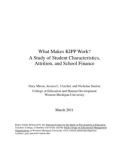By SAM DILLON | New York Times |http://nyti.ms/fwS0bX
March 31, 2011 - Most charter schoolsreceive less government money for each student, on average, than traditional public schools.
Times Topic: Knowledge Is Power Program (KIPP)
But the KIPP network, one of the fastest-growing and most academically successful charter groups, has received more taxpayer dollars per student than regular public schools, according to a new study, which also noted that KIPP receives substantial amounts of private philanthropic money.
KIPP officials disputed the report by Western Michigan University researchers, saying it significantly overstates the amount per student that the network receives from both public and private sources.
The Knowledge Is Power Program, a network of 99 schools in 20 states and the District of Columbia, has attracted more academic research than many other charter groups because of its success in raising the academic achievement of poor students, especially African-American youths.
The Department of Education last year awarded KIPP a $50 million grant to finance its growth.

Instead, they said their goal was to examine the network’s methods and model to see whether they could be replicated widely. Among other findings, the study concludes that KIPP schools enjoy significant financial advantages over traditional public schools.
By analyzing Department of Education databases for the 2007-8 school year, the researchers calculated that the KIPP network received $12,731 in taxpayer money per student, compared with $11,960 at the average traditional public school and $9,579, on average, at charter schools nationwide.
In addition, KIPP generated $5,760 per student from private donors, the study said, based on a review of KIPP’s nonprofit filings with the Internal Revenue Service.
The study does not offer an explanation for why KIPP schools would get more government financing than regular public schools.
“We can’t explain it, but that’s what the data shows,” Dr. Miron said.
Mike Wright, a senior finance official at KIPP, said the study had produced an inflated estimate of the network’s government revenues, partly because charters get most of their financing from states, which differ significantly in how much money they give charter schools for each student.
Because the study used a sample of KIPP schools that did not include any schools in California, which provides only meager financing to charters, it had produced an exaggerated picture of average government financing for the schools nationwide, Mr. Wright said.
He estimated average government financing nationwide at between $9,000 and $10,000 per KIPP student.
The study significantly inflated private revenues, Mr. Wright said, because KIPP itself had miscategorized some government money as private revenues in its reporting to the I.R.S.
In addition, the Michigan researchers mixed private donations earmarked for school construction with donations for operating expenses, thereby further inflating the study’s estimate of per-pupil operating revenues derived from philanthropy, Mr. Wright said.
He estimated KIPP’s private revenues in the 2007-8 year at about $2,500 per student, compared with the $5,760 cited in the study.
KIPP schools operate on a no-excuses model that pushes students to improve their achievement and to take responsibility.
Parents must sign a pledge that they will check students’ homework and make sure they get to school on time, among other commitments. The schools run on an extended school day during the week, and students must attend Saturday classes every other week.
Steve Mancini, a spokesman, said it cost the KIPP network, on average, $1,200 to $1,600 per student to provide the extended weekday hours, Saturday classes and other extra learning time.
The new study generated some instant debate.
Bruce Fuller, an education professor at the University of California, Berkeley, called the study’s financial analysis “eye-opening.”
“As wealthy donors have invested in KIPP, they have helped to demonstrate how a well-endowed, inspirationally run charter school can lift poor children,” Mr. Fuller said. “The question raised by this study is whether the model could be replicated if wealthy donors were to walk away.”
Grover Whitehurst, a fellow at the Brookings Institution who is a former research director at the Department of Education, also said the study’s financial analysis made a “significant contribution.”
But other parts of the report, especially its findings on student attrition, Dr. Whitehurst said, “use questionable data sources and analytic techniques to push a position that is antagonistic to KIPP.”
The Western Michigan study concluded that KIPP schools have substantially higher student attrition rates than the school districts from which they draw students.
But Dr. Whitehurst said it based that finding on a flawed methodology. Another study of attrition carried out last year by Mathematica Policy Research, he said, used far more sophisticated research techniques to conclude that, on average, KIPP schools did not have significantly higher or lower numbers of students leaving before completion than nearby public schools.
No comments:
Post a Comment